Introduction
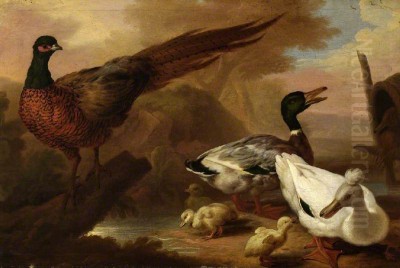
Pieter Casteels III stands as a significant figure in the transition of artistic tastes during the late Baroque and early Georgian periods, particularly within the realm of decorative painting in England. Born into an artistic family in Antwerp, the heart of Flemish art, Casteels carved a distinct niche for himself, becoming renowned for his vibrant and meticulously detailed paintings of flowers and birds. His move to England marked a pivotal point, allowing him to flourish within a receptive market eager for decorative works that combined naturalistic observation with elegant composition. His legacy is cemented not only through his numerous canvases but also through influential print series, most notably the celebrated Twelve Months of Flowers. This exploration delves into the life, work, style, and influence of an artist who successfully bridged Continental traditions with British patronage.
Early Life and Artistic Formation in Antwerp
Pieter Casteels III entered the world in Antwerp in 1684. Artistry was embedded in his lineage; his father, Pieter Casteels II, was a painter known for landscapes and historical scenes. It was under his father's tutelage that the young Pieter likely received his foundational training in drawing and painting. Growing up in Antwerp during the late 17th century meant being immersed in a city still echoing with the artistic reverberations of masters like Peter Paul Rubens and Jan Brueghel the Elder. The latter's detailed flower paintings and allegorical landscapes undoubtedly formed part of the visual culture surrounding the young artist.
Antwerp's strong tradition in still life and genre painting provided a fertile ground for developing skills in detailed observation and refined technique. While specific details of his early training beyond his father's studio are scarce, it is probable he absorbed the techniques and thematic concerns prevalent among Flemish artists of the time. This included a focus on rich colours, careful rendering of textures, and often, compositions brimming with life and detail. His brother, Frans Casteels, also pursued an artistic career. This familial and regional artistic environment shaped Pieter III's initial development before he sought opportunities abroad.
The Journey to England and Early Career
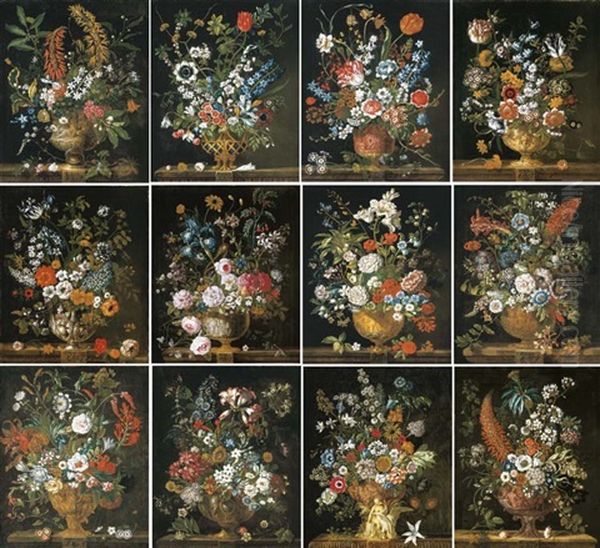
Around 1708, seeking broader horizons and potentially greater patronage, Pieter Casteels III made the significant decision to move to England. He travelled in the company of his brother-in-law, Peter Tillemans, another Flemish painter who would also find success in Britain, primarily known for his topographical views, country house portraits, and sporting scenes. London, at this time, was a burgeoning metropolis, attracting talent from across Europe. The initial phase of Casteels' career in England involved establishing himself and finding his footing.
Sources suggest that, like many immigrant artists, he initially engaged in making copies of works by Old Masters. This practice was common, serving both as a means of income and as a way to further hone technical skills while studying established compositions. His Flemish training would have equipped him well for this task. His ambition, however, lay in creating original works. A key step in integrating into the London art scene was joining the Kneller Academy of Painting and Drawing in 1711. Founded by Sir Godfrey Kneller, the leading portrait painter of the era, the academy provided a space for artists to study the human figure and connect with peers.
Establishing a Reputation in London
By 1717, Casteels had decided to settle permanently in London, a testament to the opportunities he found there. He became an active member of the city's artistic community. His involvement extended to joining the Rose and Crown Club, a less formal but significant gathering place for artists, collectors, and connoisseurs, providing valuable networking opportunities. His specialization in flower and bird painting began to attract attention, particularly among the landed gentry and aristocracy who sought decorative pieces for their newly built or refurbished homes.
His Flemish style, characterized by rich detail and vibrant palettes, appealed to British tastes, which were evolving towards a greater appreciation for decorative arts that celebrated nature, albeit often in a highly stylized and opulent manner. Casteels married into an English family, further cementing his ties to his adopted country. His client list grew to include prominent figures, notably James Stanley, the 10th Earl of Derby, indicating his acceptance within elite circles. He became one of the favoured painters for a specific type of decorative work – pieces designed to adorn interiors, often as overmantels or parts of larger decorative schemes.
The Art of the Flower Painter
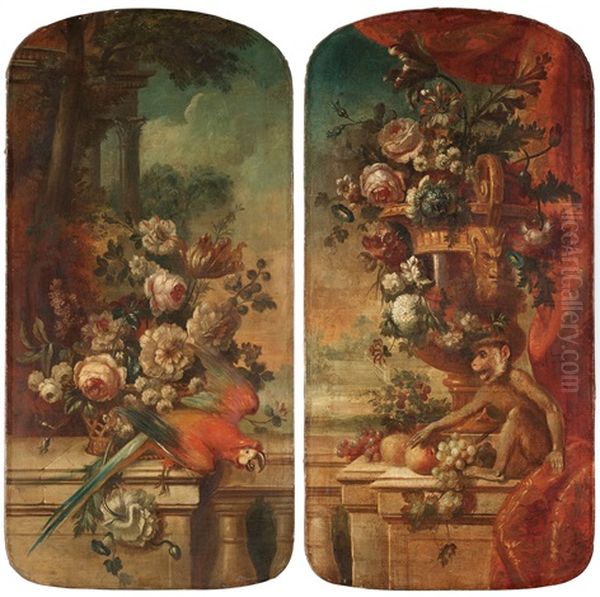
Flower painting was a genre with a rich history in the Low Countries, reaching extraordinary heights during the Dutch Golden Age with artists like Jan van Huysum and Rachel Ruysch. Casteels operated within this tradition but adapted it to the tastes of his English clientele. His flower pieces are typically characterized by their abundance and decorative flair. He often depicted lush bouquets overflowing from ornate urns or baskets, set against neutral or subtly suggested backgrounds.
Unlike the sometimes starker realism or complex allegorical content found in some earlier Dutch and Flemish flower paintings, Casteels' works often prioritize visual splendour and decorative harmony. His compositions, while detailed, can sometimes feel more arranged and less naturalistic than those of, say, Van Huysum. He demonstrated a keen eye for botanical detail, capturing the specific forms and colours of numerous flower varieties – tulips, roses, peonies, carnations, and more exotic blooms feature prominently. His palette was typically bright and varied, employing strong contrasts and rich hues to create a sense of opulence.
His approach drew inspiration from various sources. The legacy of Jan Brueghel the Elder and Daniel Seghers in the Flemish tradition provided a foundation. The highly refined and luminous works of Dutch contemporaries like Van Huysum set a benchmark for technical excellence. Furthermore, the influence of French decorative painters, particularly Jean-Baptiste Monnoyer, who had himself worked in England earlier, can be seen in the elegant, sometimes formalized arrangements and the suitability of the works for integration into interior design schemes. Casteels successfully synthesized these influences into a style that was both technically accomplished and commercially appealing in Georgian England.
Master of Avian Subjects
Alongside his flower paintings, Pieter Casteels III gained considerable renown for his depictions of birds. He painted a wide variety of avian subjects, ranging from common domestic fowl like chickens, ducks, and pigeons, to more exotic species such as peacocks, parrots, and waterfowl, often shown in elaborate garden or parkland settings. These works followed in the footsteps of earlier specialists in this genre, such as the Dutch painter Melchior d'Hondecoeter and Jacob Bogdani, a Hungarian artist who had established a successful career painting birds and flowers in England before Casteels' arrival.
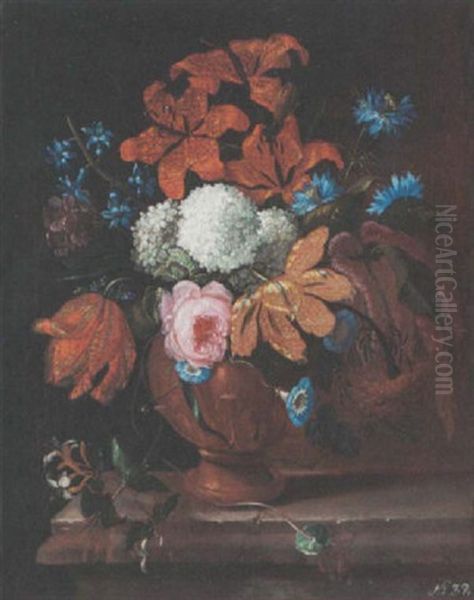
Casteels' bird paintings share the decorative quality of his floral works. The compositions often feature a large number of birds interacting within the landscape, creating lively and visually engaging scenes. Peacocks, with their iridescent plumage, were a favourite motif, allowing the artist to showcase his skill in rendering texture and colour. These paintings were frequently commissioned as large-scale decorative pieces, intended to be hung over fireplaces or set into wall panelling, contributing to the overall grandeur of aristocratic interiors.
While decorative effect was paramount, Casteels also displayed considerable skill in capturing the characteristic postures and plumage of the different species. His birds are generally lively and well-observed, even if the overall composition prioritizes aesthetic arrangement over strict naturalism. He often combined birds and flowers within the same composition, creating elaborate scenes teeming with life, colour, and intricate detail, perfectly suited to the tastes of his wealthy patrons.
The Celebrated 'Twelve Months of Flowers'
Perhaps Pieter Casteels III's most enduring legacy comes from his collaboration on the print series The Twelve Months of Flowers. This ambitious project, published in 1730, involved Casteels as the designer, the engraver Henry Fletcher, and the prominent nurseryman Robert Furber of Kensington. Furber conceived the series partly as an elaborate catalogue showcasing the variety of flowers available from his nursery throughout the year. Casteels was commissioned to create the twelve original paintings, one for each month, depicting elegant arrangements of flowers that bloomed during that specific period.
Each composition typically features an ornate urn or basket overflowing with meticulously rendered blooms, carefully labelled with numbers corresponding to a key provided on the print. Casteels' designs are sophisticated and decorative, translating the richness of his oil paintings into a format suitable for engraving. Henry Fletcher then skilfully engraved Casteels' designs onto copper plates. The resulting prints were often sold with hand-colouring, adding vibrancy and further enhancing their decorative appeal.
The Twelve Months of Flowers was a resounding success. It appealed not only to gardening enthusiasts and potential customers of Furber's nursery but also to a wider audience seeking fashionable decorative prints for their homes. The series perfectly captured the burgeoning interest in horticulture and garden design in 18th-century England. It remains a landmark publication in the history of botanical illustration and garden literature, showcasing Casteels' mastery in floral composition and his ability to work effectively within a commercial and collaborative framework. The success led to a companion series, Twelve Months of Fruit, also designed by Casteels.
'Birds drawn from the Life'
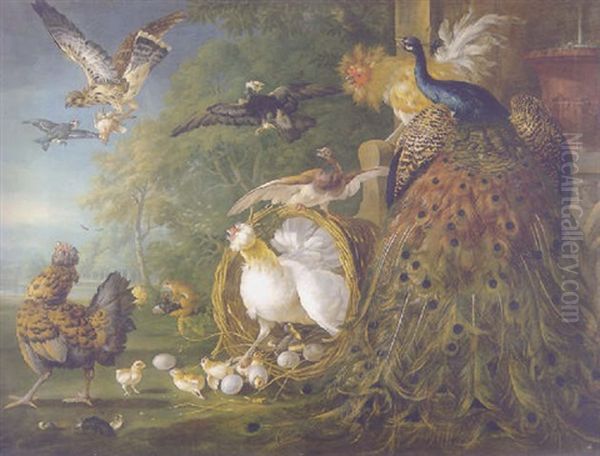
Following the success of the floral series, Casteels embarked on another significant print project focused on his other specialty: birds. He produced a series of designs for engravings titled Birds drawn from the Life and accurately coloured. Published in parts during the 1730s, this series further cemented his reputation as a leading painter of avian subjects. As the title suggests, the emphasis was on accurate representation, although the compositions still retained a strong decorative element.
These prints depicted various species, both British and exotic, often grouped together in pleasing arrangements against simple landscape backgrounds. Like the flower series, these prints were typically hand-coloured, enhancing their visual appeal and ornithological value. They served both as decorative items and as references for identifying different bird species, catering to the growing interest in natural history among the educated classes in Britain. This series, along with his numerous bird paintings, solidified Casteels' position as a key figure in the depiction of birds in British art of the period.
Collaborations and Connections
Casteels' career demonstrates his ability to navigate the London art world and engage in fruitful collaborations. His partnership with Robert Furber and Henry Fletcher on The Twelve Months series is the most prominent example, showcasing a successful synergy between art, horticulture, and commerce. His early association with his brother-in-law, Peter Tillemans, highlights the network of Flemish artists active in England.
His membership in the Kneller Academy and the Rose and Crown Club placed him in contact with many leading figures of the London art scene. While Sir Godfrey Kneller dominated portraiture, other artists focused on different genres. Casteels' work sometimes intersected with that of contemporaries. For instance, he is known to have collaborated with Marmaduke Cradock, another painter specializing in birds and animals, on illustrations for John Gay's Fables (published 1727). This project involved several prominent artists, including William Kent and John Wootton, indicating Casteels' standing within the artistic community. His style also shows awareness of, and dialogue with, predecessors and contemporaries like Jacob Bogdani and the influential French flower painter Jean-Baptiste Monnoyer, whose son Antoine Monnoyer also worked in England.
Later Career and Shift in Focus
Pieter Casteels III continued to paint throughout the 1730s and 1740s, producing numerous flower pieces, bird paintings, and decorative compositions. His works remained popular among patrons seeking elegant additions to their homes. However, towards the end of his career, there appears to have been a shift in his professional activities. Records indicate that in 1735, he held a sale of his collection of pictures and announced his intention to retire from painting and focus on designing for the burgeoning calico printing industry.
This move into textile design suggests an adaptation to changing market demands or perhaps a personal inclination towards applied arts. The skills required for designing intricate floral and avian patterns for textiles were closely related to his painting practice. While less is known about his specific contributions to textile design compared to his paintings and prints, this later phase indicates his versatility and engagement with different facets of decorative art production in Georgian England. He continued to live in London, eventually moving to Richmond.
Influence and Legacy
Pieter Casteels III died in Richmond upon Thames in 1749. He left behind a substantial body of work that significantly contributed to the tradition of still life and decorative painting in Britain. His influence can be seen in the work of subsequent artists who specialized in similar subjects. Marmaduke Cradock, his collaborator, worked in a comparable vein, as did Cradock's son, Luke Cradock. The Irish painter Samuel Dixon, known for his delicate watercolour and gouache depictions of birds and flowers on vellum (basso-relievo), also operated within this decorative tradition.
Casteels' primary legacy lies in his successful adaptation of Continental Baroque styles – particularly Flemish richness and Dutch detail – to suit English tastes for decorative elegance. His paintings provided the models for fashionable interior decoration, and his print series, especially The Twelve Months of Flowers, had a lasting impact on botanical illustration and print culture. They were widely copied and imitated for decades.
Today, his paintings are held in numerous public and private collections, particularly in the United Kingdom, including the Tate Britain, the Yale Center for British Art, and various National Trust properties. His works continue to be appreciated for their technical skill, vibrant colours, and decorative charm, offering a window into the aesthetic preferences of Georgian England. He remains a key figure for understanding the role of specialist immigrant artists in shaping British art and design during the 18th century.
Conclusion
Pieter Casteels III was more than just a painter of flowers and birds; he was a skilled artist who successfully navigated the cultural and commercial landscape of 18th-century London. Arriving from Antwerp with a solid Flemish training, he adapted his style to meet the demands of a new market, becoming a leading provider of decorative paintings for the British elite. His work, characterized by vibrant colours, meticulous detail, and elegant compositions, adorned the walls of numerous country houses and town residences. Through his influential print series, particularly The Twelve Months of Flowers, created in collaboration with Furber and Fletcher, he reached an even wider audience, leaving an indelible mark on botanical illustration and decorative arts. His career exemplifies the fruitful exchange between Continental artistic traditions and British patronage, securing his place as an important figure in the history of Georgian art.